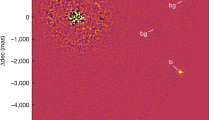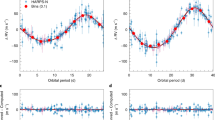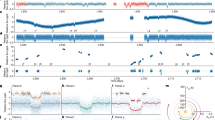Abstract
Doppler spectroscopy has detected 152 planets around nearby stars1. A major puzzle is why many of their orbits are highly eccentric; all planets in our Solar System are on nearly circular orbits, as is expected if they formed by accretion processes in a protostellar disk. Several mechanisms have been proposed to generate large eccentricities after planet formation, but so far there has been little observational evidence to support any particular model. Here we report that the current orbital configuration of the three giant planets around upsilon Andromedae2,3 (υ And) probably results from a close dynamical interaction with another planet4, now lost from the system. The planets started on nearly circular orbits, but chaotic evolution caused the outer planet (υ And d) to be perturbed suddenly into a higher-eccentricity orbit. The coupled evolution of the system then causes slow periodic variations in the eccentricity of the middle planet (υ And c). Indeed, we show that υ And c periodically returns to a very nearly circular state every 6,700 years.
This is a preview of subscription content, access via your institution
Access options
Subscribe to this journal
Receive 51 print issues and online access
$199.00 per year
only $3.90 per issue
Buy this article
- Purchase on Springer Link
- Instant access to full article PDF
Prices may be subject to local taxes which are calculated during checkout




Similar content being viewed by others
References
Schneider, J. Extra-solar Planets Cataloghttp://cfa-www.harvard.edu/planets/catalog.html (2005).
Butler, R. P. et al. Evidence for multiple companions to Upsilon Andromedae. Astrophys. J. 526, 916–927 (1999)
Fischer, D. A. et al. A planetary companion to HD 40979 and additional planets orbiting HD 12661 and HD 38529. Astrophys. J. 586, 1394–1408 (2003)
Malhotra, R. A dynamical mechanism for establishing apsidal resonance. Astrophys. J. Lett. 575, L33–L36 (2002)
Rasio, F. A., Tout, C. A., Lubow, S. H. & Livio, M. Tidal decay of close planetary orbits. Astrophys. J. 470, 1187–1191 (1996)
Stepinski, T. F., Malhotra, R. & Black, D. C. The Upsilon Andromedae system: models and stability. Astrophys. J. 545, 1044–1057 (2000)
Chiang, E. I., Tabachnik, S. & Tremaine, S. Apsidal alignment in Upsilon Andromedae. Astron. J. 122, 1607–1615 (2001)
Rasio, F. A. & Ford, E. B. Dynamical instabilities and the formation of extrasolar planetary systems. Science 274, 954–956 (1996)
Weidenschilling, S. J. & Marzari, F. Gravitational scattering as a possible origin for giant planets at small stellar distances. Nature 384, 619–621 (1996)
Chiang, E. I. & Murray, N. Eccentricity excitation and apsidal resonance capture in the planetary system Upsilon Andromedae. Astrophys. J. 576, 473–477 (2002)
Goldreich, P. & Sari, R. Eccentricity evolution for planets in gaseous disks. Astrophys. J. 585, 1024–1037 (2003)
Lin, D. N. C. et al. in Protostars and Planets IV (eds Mannings, V., Boss, A. P. & Russell, S. S.) 1111–1178 (Univ. Arizona Press, Tucson, 2000)
Lissauer, J. J. & Rivera, E. J. Stability analysis of the planetary system orbiting Upsilon Andromedae. II. Simulations using new Lick Observatory fits. Astrophys. J. 554, 1141–1150 (2001)
Lystad, V. & Rasio, F. in The Search for Other Worlds (eds Holt, S. S. & Deming, D.) 273–276 (AIP Conf. Proc. 713, American Institute of Physics, New York, 2004)
Ford, E. B., Havlickova, M. & Rasio, F. A. Dynamical instabilities in extrasolar planetary systems containing two giant planets. Icarus 150, 303–313 (2001)
Ford, E. B., Rasio, F. A. & Yu, K. in Scientific Frontiers in Research on Extrasolar Planets (eds Deming, D. & Seager, S.) 181–187 (ASP Conf. Ser. 294, Astronomical Society of the Pacific, San Francisco, 2003)
Marzari, E. F. & Weidenschilling, S. J. Eccentric extrasolar planets: the jumping Jupiter model. Icarus 156, 570–579 (2002)
Holman, M., Touma, T. & Tremaine, S. Chaotic variations in the eccentricity of the planet orbiting 16 Cyg B. Nature 386, 254–256 (1997)
Bodenheimer, P., Hubickyj, O. & Lissauer, J. J. Models of the in situ formation of detected extrasolar giant planets. Icarus 143, 2–14 (2000)
Ford, E. B. Quantifying the uncertainty in the orbits of extrasolar planets. Astron. J. (in the press)
Chambers, J. E. A hybrid symplectic integrator that permits close encounters between massive bodies. Mon. Not. R. Astron. Soc. 304, 793–799 (1999)
Murray, C. D. & Dermott, S. F. Solar System Dynamics (Cambridge Univ. Press, New York, 1999)
Gladman, B. Dynamics of systems of two close planets. Icarus 106, 247–265 (1993)
Acknowledgements
We are very grateful to D. Fischer for providing us with the latest radial velocity data on υ And. We also thank E. Chiang, M. H. Lee and S. Peale for discussions. This work was supported by an NSF grant to F.A.R. at Northwestern University and by a Miller Research Fellowship to E.B.F. V.L. acknowledges support from the NASA Undergraduate Summer Research Program at Northwestern. F.A.R. and E.B.F. thank the Kavli Institute for Theoretical Physics for hospitality and support.
Author information
Authors and Affiliations
Corresponding author
Ethics declarations
Competing interests
The authors declare that they have no competing financial interests.
Supplementary information
Supplementary Methods
This provides technical details related to the algorithm for sampling from the posterior probability distribution for the masses and orbital parameters. (PDF 21 kb)
Supplementary Discussion
This explains the choice of initial conditions used for the calculation presented in Fig. 4. It also discusses the timescale constraints which rule out the possbility that the impulsive perturbation to Ups And d was delivered by a massive exterior primordial disk with a large viscosity. (PDF 24 kb)
Rights and permissions
About this article
Cite this article
Ford, E., Lystad, V. & Rasio, F. Planet–planet scattering in the upsilon Andromedae system. Nature 434, 873–876 (2005). https://doi.org/10.1038/nature03427
Received:
Accepted:
Issue Date:
DOI: https://doi.org/10.1038/nature03427
This article is cited by
-
Multimodal Fluorescent Polymer Sensor for Highly Sensitive Detection of Nitroaromatics
Scientific Reports (2019)
-
A Comparison Study of Physicochemical Properties and Stabilities of H-Shaped Molecule and the Corresponding Polymer
Chinese Journal of Polymer Science (2019)
-
Characterizing multi-planet systems with classical secular theory
Celestial Mechanics and Dynamical Astronomy (2012)
-
Trapping in three-planet resonances during gas-driven migration
Celestial Mechanics and Dynamical Astronomy (2011)
-
The Solar System's extended shelf life
Nature (2009)
Comments
By submitting a comment you agree to abide by our Terms and Community Guidelines. If you find something abusive or that does not comply with our terms or guidelines please flag it as inappropriate.



